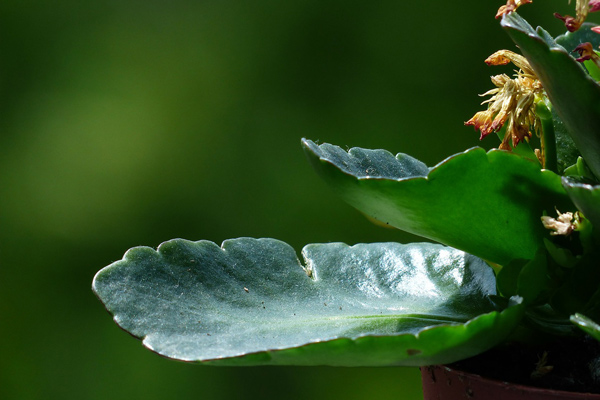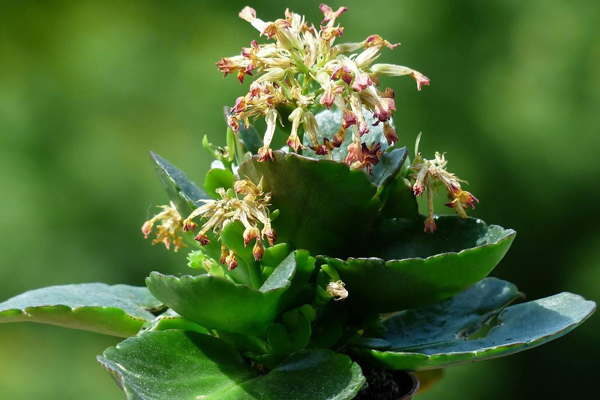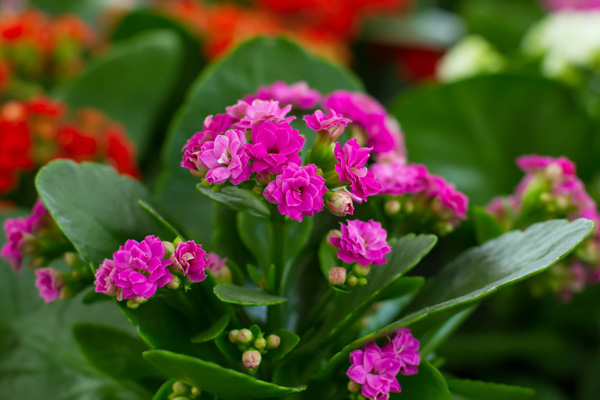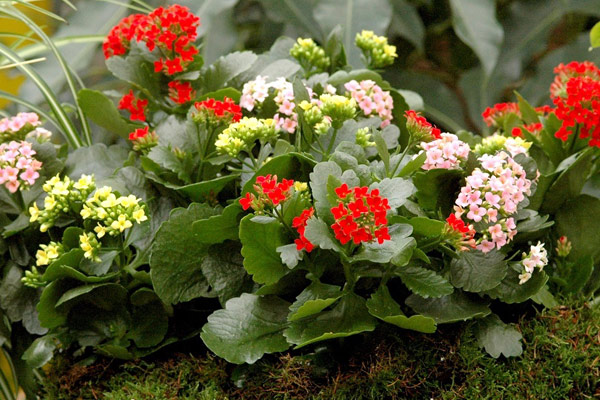Kalanchoe Plant Care & Grow Guide

Florist kalanchoe, flaming Katy, widow’s thrill, Christmas kalanchoe (because of the time of year you see it in stores), or simply kalanchoe plant, whatever you call it, it deserves all the credit it receives as a houseplant. Kalanchoe flower is a succulent that requires minimum care and produces charming blooms, not for a short time but year-round provided ideal condition and care.
In this article, we are going to talk about kalanchoe blossfeldiana, one of the most well-known and favored types of this species. After knowing a little bit more about this variety and its family, you will find all the necessary information about kalanchoe plant care, how to encourage it to rebloom, as well as its propagation, and common problems.
Kalanchoe Blossfeldiana Info
Native to Africa, Madagascar to be more precise, the kalanchoe plant is a perennial succulent from the Crassulaceae family. The plant inherits its botanical name (kalanchoe blossfeldiana) from Robert Blossfeld, the botanist who discovered it in Madagascar.
In its natural habitat, this upright plant can reach up to almost 18 inches in height and 6 to 8 inches in width. Kalanchoe flowers are found in beautiful shades of red, orange, magenta, pink, yellow, and white. These beautiful blooms are not fleeting and can last for up to 8 weeks.
When growing outdoors, it normally blooms in the spring. However, as indoor houseplants, they can be encouraged to bloom nearly year-round. In the following parts, we will tell you how to encourage your kalanchoe blossfeldiana to rebloom and make them last for as long as possible.
Before that, let us review some of the most popular kalanchoe varieties for cultivation:
Kalanchoe Varieties
Intriguingly, this genus has over 100 species. Some of which are more favored as garden plants and/or houseplants:
- Panda Plant (K. tomentosa): an erect evergreen species with soft, fuzzy, and fleshy leaves with brown stitching along the edges and tips. Primarily grown for its unusual foliage, this variety does not bloom as often as other kalanchoe plants.
- Chandelier Plant (K. manginii): the thin, narrow, fleshy leaves of this species bear large, bell-like pendant flowers that prolong in moist air. This variety is sometimes mistaken as the mother of thousands.
- Paddle Plant (K. thyrsiflora): often confused with Kalanchoe luciae, this plant has a rosette of fleshy rounded grey-green leaves with faded red margins covered with a white powdery bloom. It is also known as Bird’s Brandy, Desert Cabbage, (Yellow) Flapjacks, Ice Sculpture, and White Lady Kalanchoe.
- Pearl Bells (K. porphyrocalyx): also known as the Kalanchoe Wendy, this charming kalanchoe plant consists of slender, rectangular leaves and purple pendant flowers.
- Elephant Ear Kalanchoe (K. beharensis): as the name indicates, this plant is mostly known for its large, velvety leaves that have a pale green color.
- Mother of Thousands (K. daigremontiana): this kalanchoe succulent displays leaves that vary in size, color, and shape. They are dark green, pink-green to purplish-green with brown-red spots and grow on decumbent, brownish stems.
- Cathedral Bells (K. pinnata): fleshy green leaves and tiny plantlets along their margins are the most prized features of this kalanchoe plant.
It is interesting to know that kalanchoe varieties are often referenced in folklore and commonly used in traditional medicine to treat fever, abscesses, coughs, infections, hypertension, rheumatism, inflammation, skin diseases, bruises, and contused wounds.

Kalanchoe Plant Care Indoors
In warm climates (about zone 9 and up), you can grow kalanchoe blossfeldiana outdoors easily. However, in most cases, most people enjoy growing it as a houseplant in lower zones. Here is everything you need to know about kalanchoe plant care indoors:
Keep in Mind: This plant is a slow-growing species that takes between 2 to 5 years to reach mature size on average. Also, keep your kalanchoe flower away from pets as it is toxic if eaten.
Light
Find your kalanchoe blossfeldianah a bright area and provide it with a lot of natural light. Warm, sunny windows are perfect during summer. But in the winter, place it in a west- or south-facing window. If you have bought a plant that is already blooming, you can place it in a spot with less light to help prolong the blooming period and kalanchoe flowers. At this point, the plant can tolerate cooler conditions.
This is because the kalanchoe flowering season and its bloom cycle start after a roughly 6-week period where the plant experiences at least 14 hours of darkness each day. About 4 months after this period, it will produce flowers. Therefore, if you can simulate this winter darkness, you can possibly keep the plant blooming almost year-round.
In both cases, however, avoid placing it in direct sunlight so the leaves do not scorch, and blooming is not reduced.
Water
When it comes to kalanchoe plant care, watering is not very different compared to other succulents. So only water the plant when the s first few inches/centimeters of the soil has dried out completely. When watering, avoid pouring water on the leaves to prevent blemishes and rot.
In kalanchoe indoor care, bottom watering is a good idea to provide it with the water it needs without the risk of potential problems. In bottom watering, you do not need to leave the plant in water. Simply give it a drink and place it back where it was.
In winters, you can reduce kalanchoe blossfeldiana watering, and if ever you forgot an irrigation session, do not worry about it. These succulents are forgiving about skipping watering occasionally.
Soil
In their natural habitat, kalanchoe succulents grow in sandy, well-drained, acidic soils, which is perfect for growing this species outdoors.
In kalanchoe plant care indoors, however, kalanchoe blossfeldiana thrives best in a potting mix that does not retain too much moisture. A mix of ½ potting soil and ½ percent cactus mix, or 3/5 peat moss and 2/5 perlite will work just fine.
Temperature
Whether it is kalanchoe indoor care or outdoor care, this fascinating plant can handle a variety of temperatures, as long as it does not experience frost (which can kill it instantly). In general, the ideal temperature to grow kalanchoe indoors is about 60 to 85 degrees Fahrenheit.
Similar to their temperature requirements, kalanchoe flowers are not fussy about air moisture levels either.
Fertilizer
In kalanchoe flowering season (before it blooms), in spring, feed your plant using a well-balanced organic liquid fertilizer once a month until the end of summer months. Keep in mind that although as a flowering plant this variety kalanchoe benefits from fertilizer, it does not require it as much as many other plants.
So, avoid fertilizing during the winter and If flowering is sparse, use a fertilizer that is higher in phosphorus. In kalanchoe flower care for outdoors, a little more than a single light feeding in the spring will suffice.
Potting and Repotting
For proper drainage and preventing an overly moist environment, it is recommended to plant your kalanchoe blossfeldiana in a clay pot that is porous and absorbs excess water from the soil.
Interestingly, this plant does not like to be pot-bound. So for the best growth, re-pot your plant annually each fall when the kalanchoe flowering season is finished in a container that is one size bigger.
Pruning
To maintain the shape and promote more blooms, simply pinch back the stems.

How to Encourage Kalanchoe Flowers?
Having the kalanchoe plant care tips in mind, this plant blooms year-round in an ideal environment. To enjoy the flowers frequently, ample sunlight is essential. So, make sure to place the pot in a location with at least 6 to 8 hours of bright light each day.
During the fall and winter, it is important that kalanchoe blossfeldiana experiences roughly total darkness for the other hours of the day. As mentioned earlier, 14 hours of daily darkness for about 6 weeks is necessary so the plant has enough energy for blooming later. To prompt continual flowering, deadheading the flowers once the blooms are spent is also a great way.
To help your plant achieve its full flowering potential, use a fertilizer blend that has high phosphorus. Such fertilizers help in producing more buds in the next blooming period.

Kalanchoe Succulent Common Problems and Pests
This plant is incredibly easy to grow; especially when you pay attention to kalanchoe plant care and it does not experience improper watering or temperature extremes.
The most usual indoor plant pests that could affect this variety are scale, mealybugs, aphids, and spider mites. And here are its most common problems:
Wilting Leaves
If the leaves look limp, it is possible you are underwatering or overwatering your kalanchoe flower. Although, overwatering can lead to root rot as well. In addition to adjusting the watering, watch the plant base through the foliage closely, so you can easily spot problems before they get worse.
Another probable reason is temperatures that are too high. So, make sure that you are keeping the plant where it experiences temperatures below 80 degrees Fahrenheit.
Kalanchoe Flowers Drooping
If the problems discussed above are not the case, kalanchoe flowers drooping is may be due to stress from being repotted while in bloom. This is normal and does not require any action. Although, you could support it using some twine and small sticks.
Pale or Burned Leaves
Failing to provide proper light for kalanchoe blossfeldiana causes both of these problems. Too little light will make the leaves drab while prolonged direct sunlight can scorch them. While growing indoors, place your plant in a location that receives a lot of bright indirect light, but not too much harsh direct sunlight.
Soft Stems
Overwatering or planting it in a potting mix that retains water leads to root and stem rot. If you notice fragile stems, do not water until the plant recovers.

Kalanchoe Plant Propagation
Similar to kalanchoe flower care, its propagation is convenient while boosting its health as well. IF you have a mature plant, you are sure to have seen its offsets. If left alone, they leech nutrients from the mother plant. However, whenever you like, you can propagate these offsets or take stem cuttings.
For kalanchoe plant propagation using stem cuttings or offsets, follow these steps:
- Using a sharp clean knife, remove a stem segment several inches long. If decided to use offsets, remove it at the joint where it connects to the parent plant.
- Let the cutting dry out for a few days, or the end is calloused. Once healed, dip this end in a rooting hormone.
- Plant the cutting in a similar potting mix that the mother plant has. Place the kalanchoe blossfeldiana in bright indirect light, but do not water. The stem should root within a month.
After that, you can treat it like a mature plant.
- In this post:
- Kalanchoe Blossfeldiana Info
- Kalanchoe Plant Care Indoors
- How to Encourage Kalanchoe Flowers?
- Kalanchoe Succulent Common Problems and Pests
- Kalanchoe Plant Propagation



